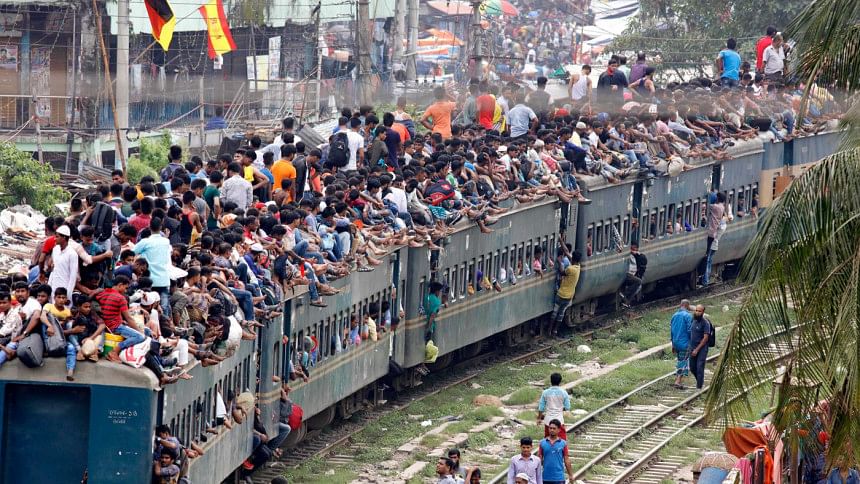Revive the past glory of the railway

When it comes to long distance travelling, nothing can replace the railway. Beginning around 1880, the Bengal railway expanded soon to bring Assam and East Bengal under its folds. It brought faraway lands nearer to our doorsteps. Trade and commerce got a big boost and, on the sidelines, the postal service also developed and expanded with the railway going deep into the hinterlands.
Since the steam engine days, the coal-fired locomotive kept us enthralled with its speed, the staccato sound and the smell of the hot steam from the engine that huffed and puffed its way through the forests and hills. The hoot and toot of the whistle every now and then would bring young and old scurrying out of their homes, as the train ran past like a huge serpent through the villages. Perhaps this image has been brilliantly captured in the celluloid by Satyajit Ray in his film "Pather Panchali."
Bengal on both sides of the divide has seen the heydays of railway in the 40s, 50s and 60s, offering useful services to the common people as the cheapest mode of transportation. In a sleepy little town, the coming and going of a train became the occasions of significant activities. Railway became the largest employing sector for the unemployed, and most development activities were centred on it for decades. The railway department could acquire huge land whenever it needed. Massive-scale workshops were built at strategic locations, and huge ponds were dug to store water. Supplying coal to the railway was a lucrative business for local businessmen those days.
Train services necessitated the construction of big and small bridges over rivers and canals. Great bridges like the Hardinge Bridge and the Howrah Bridge were built during British rule, and they still stand tall to tell the story of human ingenuity. Steamer companies also benefited from adjusting their schedules with that of the train. Goalundo ghat and Bahadurabad ghat now remain in our memory only.
No narrative can depict in full the actual contribution to the socio-economic development of the railway in our side of the world. Many office-goers took the morning train to reach Kolkata or Dhaka in time to attend office at 10am. On a lighter note, it also played a significant role in many of our novels and cinema. Bengal railway was used in the film "Around the World in 80 Days," a Hollywood classic blockbuster.
Gone are the halcyon days of the railway, but romanticism mixed with nostalgia grips us whenever we think of the trains of the yesteryears. How can one forget the "Green Arrow" train that ran between Dhaka and Chattogram in the 60s? Over the last five decades, railways have witnessed great changes all over the world. Super speed trains with luxurious interiors and five-star services have been introduced in developed countries.
In Bangladesh, however, we have not seen much improvement in terms of quality of locomotives as well as services. One by one, small stations closed down as the railway authorities could not compete with the burgeoning road transports. Valuable parts on the tracks and stone chips needed to keep them intact were stolen by thugs in cahoots with some insiders. Huge sums of money were spent in the name of repair and maintenance of old diesel engines over the decades. Diesel by the gallons has been siphoned away from the depots by powerful thieves who belonged to the railway department. The magnitude of corruption in all the departments of Bangladesh Railway became legendary as it was left to be plundered by all and sundry.
Every year, we have become accustomed to hearing the story of how Bangladesh Railway incurred losses to the tune of thousands of crores of taka. With rampant theft of diesel, deteriorating passenger services and corruption in the purchase of equipment and employment of manpower, it does not surprise us to read about the losses. A report in this daily said that the railway lost Tk 1,384 crore in the 2020-21 fiscal year. Meanwhile, in the last fiscal, it earned Tk 1,427.70 crore but spent Tk 2,822.29 crore.
The Bangladesh Railway papers show that around 5,000 acres of railway land has gone under illegal occupation, but there are stories of malpractice by the officials in each case of land- or property-grabbing. Powerful people with political backing take possession of railway land on lease, and then construct structures on them.
If we go further back, we shall see that in August 2011, the government took up a Tk 1,946 crore project to procure 70 metre gauge (MG) locomotives to address the growing crisis of rail engines and expanding the services of Bangladesh Railway. The locomotives were supposed to reach within June 2017, but the project authorities could not even complete the bidding process by that time. The deadline was extended twice before the project went through a major revision in 2018, when the costs jumped to Tk 2,659.33 crore. The deadline was extended to June 2024.
The stories of incompetence, unprofessionalism, outright looting, bungling, mismanagement and pervasive corruption would make the article much longer. We can only hope the current minister would take firm steps without fear or favour to bring Bangladesh Railway back on track and turn it into a profitable sector.
Shahnoor Wahid is a senior journalist.

 For all latest news, follow The Daily Star's Google News channel.
For all latest news, follow The Daily Star's Google News channel. 



Comments